Padarm “Fountain of Tears” as the pinnacle of skill of the knight Jacques de Lalaine
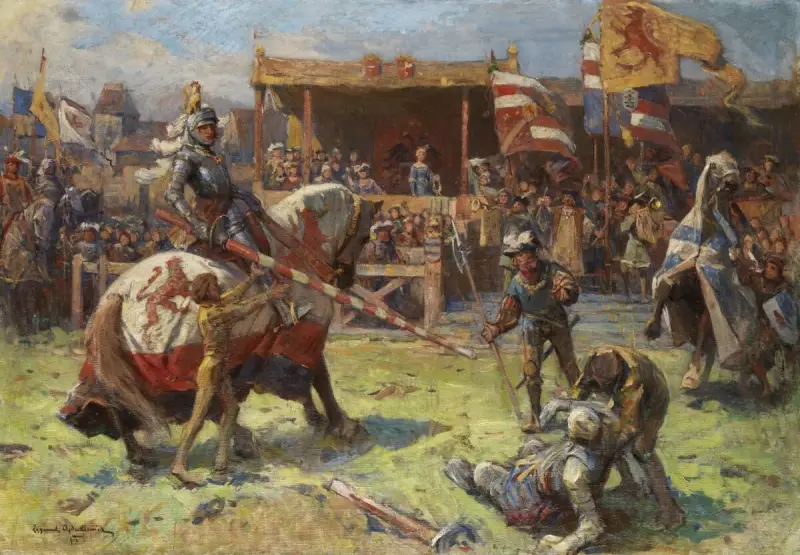
Of historical Chronicles and various medieval sources indicate that we largely owe the formation of knightly tournaments to France. The prerequisites for classical knightly tournaments can be found already in the 1th century. In particular, mentions of tournaments of the XNUMXth century were in the works of the chronicler Nidgard, which tells about the competition between the Frankish warriors Louis the German and Charles the Bald. From the chronicler’s description it can be understood that the demonstration competition took place in a specially selected open place, where at the appointed time the cavalry armies of two brothers met in a training battle [XNUMX].
The word tournament “tornei” itself is of French origin. Initially, tournaments could only be found in France and Germany, and only from the 1th century can one find mention of tournaments in England and Italy. Thus, Matvey Parizhsky, in his work on the history of England, calls tournaments Gallic battles, which once again indicates the ancestral home of the competition [XNUMX].
One of the varieties of knightly tournament that existed in the 1096th–XNUMXth centuries was the padarm (pas d'armes). The concept of padarma was an extreme development of the fashion for individual jousting, which began to flourish at the end of the XNUMXth century. It is possible, however, that he had more ancient roots: hints of this are already in the story of Anna Komnena (Byzantine princess, sister of the Byzantine Emperor Alexios) about a French knight who arrived in Constantinople in XNUMX and told her father the following:
One of the most famous padarms was the "Fountain of Tears", organized by the knight errant from Burgundy, Jacques de Lalaine.
A little about the history of padarms
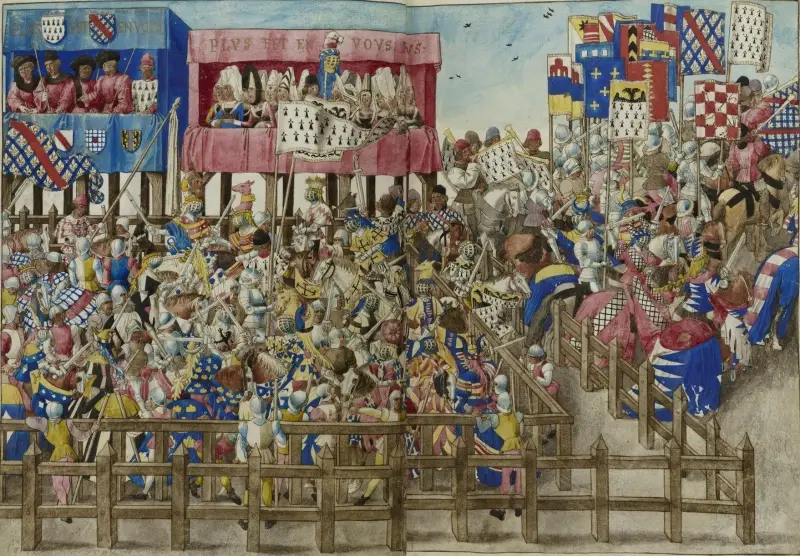
Group fight of knights “inside the barriers”. Miniature from the "Tournament Book" of King René of Anjou
Immediately after the end of the duel between the errant knight Jacques de Lalaine and the English esquire Thomas Ke (read about this in detail in the material “Knight Errant Jacques de Lalen and his exploits) Jacques asked the Duke of Burgundy, Philip the Good, to hear a herald's proclamation, which contained the terms of a new emprise, which would take the form of a pas d'armes, "defense of the pass" - a form of tournament in which the performer of the emprise assumes the role of defender of a certain place or territory and undertakes fight anyone who challenges him [3].
As historian Maurice Keane notes, the padarms clearly contain echoes of a judicial duel, during which a person is faced with judges and weapons in his hands he defends his rights and his honor or the rights and honor of his lady. Both of these situations – holding the “passage” and a duel in the name of defending honor – were readily used in literary and theatrical developments [2].
Vadim Senichev in the book “The Last Knight Errant” writes that the padarm owes its origin to the tradition of a knight going back to the 3th century to protect one or another bottleneck: a path, a gate, a bridge or their equivalent from all the knights passing along it. The tournament organizer, who took on the role of defender, thus became the main figure of the tournament, and its success, unlike the traditional jostra, where all participants have equal conditions and the opportunity to win or lose, in the case of padarm completely depends on the defender’s fulfillment of his plans, be it the number of fights , broken spears or the days that he will stay on the lists [XNUMX].
Lalen's padarm was not unique; it is simply the most detailed record of it. However, there are many other examples of padarms - Arbre de Charlmagne ("The Tree of Charlemagne"), held in 1443, Rocher Perilleux ("Dangerous Cliff"), held in 1445, La bergere ("The Shepherdess"), held in 1449 [ 2].
For the pas d'armes of the 4th century, a fictitious romantic situation was created. The basis of everything here is romantic decor [1449]. For example, for the pas d'armes "The Shepherdess", staged in 2 in Garascon, René of Anjou chose a pastoral design. The gallery for spectators resembled a reed hut, and in one of the corners of the lists sat a “shepherdess” (Rene’s favorite, Jeanne de Laval), and two “shepherd knights” threw down a gauntlet from behind her: one with a black shield of melancholy to those who were lucky in love, and the second - with a white shield of liesse (happiness) to those lovers who failed [XNUMX].
The “Tree of Charlemagne” padarm, staged by the brilliant Burgundian nobleman, knight of the Golden Fleece and outstanding tournament fighter of the time Pierre de Boffremont, lord of Charny (c. 1400–1472) in the summer of 1443 near Dijon, caused a lot of noise in its time . It was described in sufficient detail in numerous chronicles, including the “Chronicles” of Enguerrand de Monstrelet and the “Memoirs” of Olivier de La Marche, who himself was present at this tournament. Here's how its scenery is described:
And above the said tapestry were hung two shields dotted with tears: on the right a purple shield with black tears for foot fights and on the left a black shield with golden tears for horse fights <…>.
Not far from the Tree of Charlemagne there is a fountain, large and beautiful, which the aforementioned de Charny lined with stone with capitals. On the tops of these were depicted the Lord, the Virgin Mary and Madame Saint Anne, and along the capitals were carved in stone thirteen coats of arms of the said lord de Charny and his companions.
A little ahead of the high road that turned towards Dijon, there was a stone cross with a crucifix, near which the said lord’s cloak, worn over armor, a basinet and weapons for fighting in barriers were displayed” [5].
As V. Senichev notes, Jacques de Lalaine was inspired to hold the padarm “Fountain of Tears” by the padarm at San Inglevert, which attracted great attention and brought great fame to its participants. His description has come to us thanks to the biography of Jean le Mengres, also known as “Boucicaut,” Marshal of France, hero of the Battle of Nicopolis and one of the ideals of chivalry in the second half of the 3th century [XNUMX].
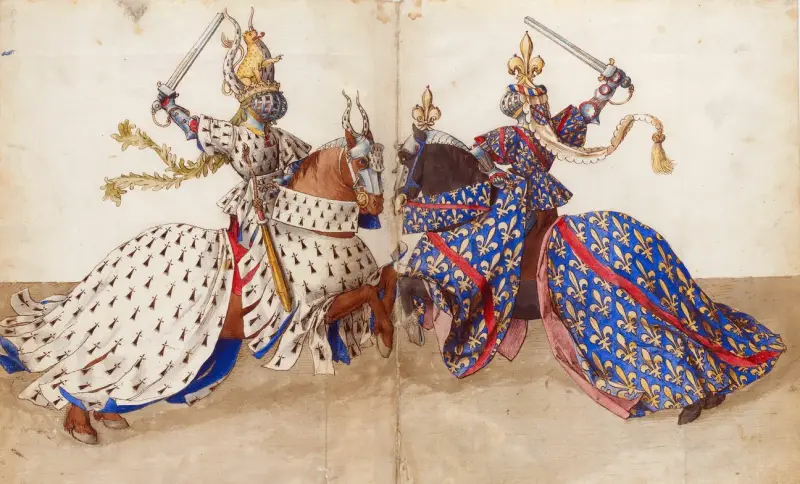
Miniature from the Tournament Book of King René of Anjou
Boucicault, who from a young age participated in military campaigns and tournaments, known for his philanthropy in favor of widows and orphans, founded the Order of the White Lady of the Green Shield (Ordre de la Dame Blanche en l'Escu Vert), designed to protect widows and orphans who became such after the memorial defeat at Nikopol. One of the significant exploits of Le Mengres was the emprise, undertaken by him with two comrades and carried out at the beginning of 1390 with the permission and under the patronage of the King of France and the Duke of Bourbon [3].
The essence of the emprise was this: Le Mengres and his two companions, Renaud de Royer and Monsieur de Sempi, intended to hold the field near the town of Saint-Inglevert, between Calais and Boulogne, for thirty days from March 20 to April 20, unless they were distracted from this the fulfillment of vassal duty. All three will be ready to fight in five jostra courses on tournament or combat spears on any day of the week except Friday [3].
Having completed fifteen jostra courses on the first day of the tournament, Le Mengres received much praise. His comrades also performed well on the first day. During the thirty days that the emprise lasted, Boucicault fought with John Holland, Henry, Lord of Derby (later King Henry IV), and he went through not five, but ten courses of jostra with Boucicault, since his father sent him a letter in which it was said that the son should learn the art of chivalry from the French champion.
Some of the challenger knights were wounded, but the defenders remained unharmed, although the chronicle of Saint-Denis claims that Boucicault himself was wounded, but his biographer contradicts this, perhaps to show his hero in a better light [3].
Organization of the padarma “Fountain of Tears”
As stated above, the terms of the emprise known as La Fontaine des pleurs ("The Source of Tears" or "The Fountain of Tears") were announced by Jacques de Lalaine immediately after the conclusion of the duel with Thomas Ke (Q). After this, Jacques began preparing for the organization of the tournament.
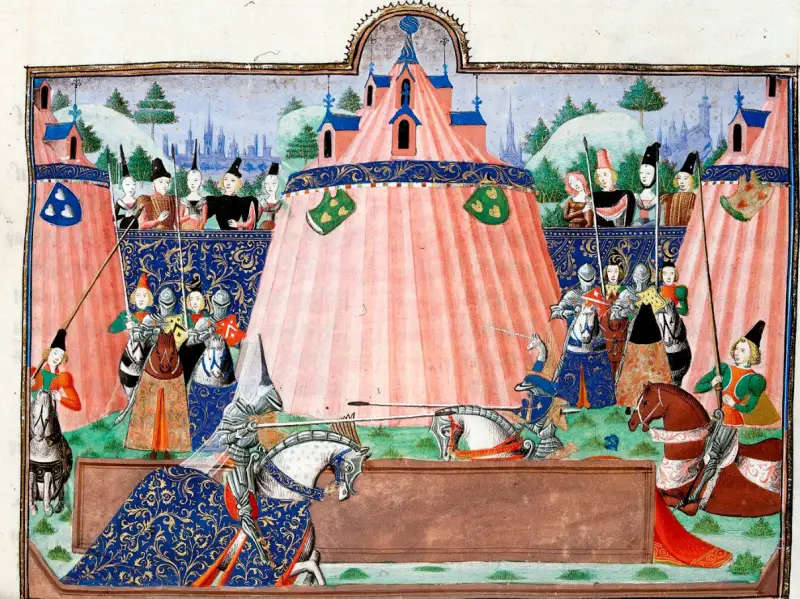
On the first day of November 1449, Jacques pitched his tent on an island in the middle of the Saone River and decorated its top with an image of the Virgin Mary. On the left side of the tent he placed a statue of a lady in a dress decorated with white tears, around whose belt a piece of beautiful fabric was wrapped. Her hair fell to her toes, and her head was adorned with a simple scarf, with which she wiped away the blue tears that rolled from her eyes. The tears flowed into a fountain, three pipes of which directed water to three shields hanging on the unicorn's neck [3].
Three shields denoted three types of combat, which were stipulated by the rules of empriza - the first was white, for a duel with axes, the second was purple, for a duel with swords, and the third, located at the bottom in such a way that a triangle was formed, black, for a duel with spears. All the shields were completely covered with blue tears.
Each knight, if he touches one of the shields or orders his squire to do so, binds himself with a vow to enter into a duel with the defender of the source, the conditions of which are most carefully formulated in chapitres [articles], which are both a written challenge and a description of the conduct of the fight. Only the knight who was in the saddle could touch the shields, which is why knights always had to find horses for themselves [4].
The Fountain of Tears tournament officially opened on November 1, 1449. In less than two years, the Good Knight without fear and doubt would turn 30 years old, and he intended to celebrate the anniversary by defeating 30 opponents. The tournament lasted from November 1, 1449 to September 30, 1450.
Le Livre reports that no one dared to challenge de Lalin in November, December or January, probably because the winter weather was unsuitable for long-distance travel. The first challenger touched the shield only in February [3].
Padarm as the pinnacle of tournament skill of Jacques de Lalaine
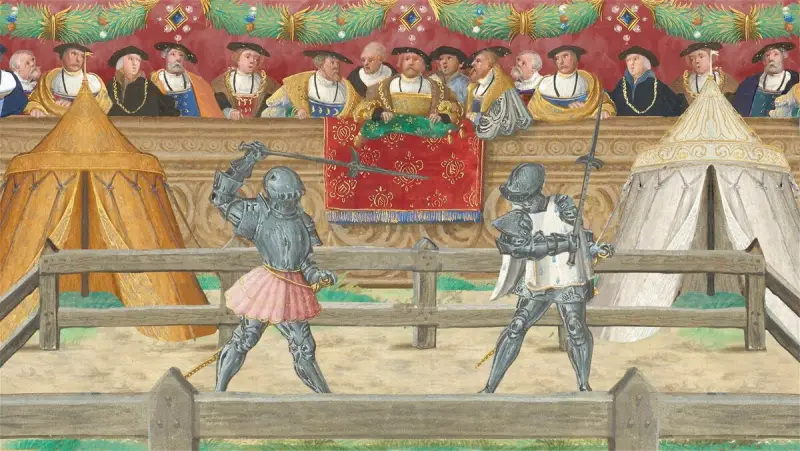
On February 1, a Burgundian knight named Pierre de Chandio, nephew of the Comte de Charny, accepted the challenge of Jacques de Lalaine. The herald of the applicant, on his instructions, touched the white shield. The fight itself took place a week later.
On the appointed day, Chandio arrived in all the splendor of splendor, as befitted a representative of one of the noblest Burgundian families, accompanied by a retinue of 600 people. The chronicles note that neither fighter gained much of an advantage over the other - both of them threw strong and deft blows, trying to show themselves. After each knight struck 21 blows, the judges stopped the fight.
In March, Jacques' challenge was accepted by Jean de Boniface, a Sicilian knight who had already fought de Lalaine at Ghent in 1445. Last time Jean de Boniface lost and was eager to fight again and win. He touched the black and white shields, thereby challenging Jacques to a horse-spear duel followed by a foot fight with axes, that is, the scenario of their first duel was practically repeated [6].
However, if during the last spear duel Jean had a slight advantage, this time Jacques de Lalen had the advantage - he broke more spears and landed several blows to the enemy’s head. Before the eighth course of the jostra, Boniface noticed that one of the elements of his armor was lost and there was no replacement for it, so the judges decided that there was no need to continue the jostra if it was a threat to life [3].
A few days later, an ax fight took place between Jacques and Jean. Having struck 10–12 blows, Jacques de Lalen managed to get close to Boniface and, grabbing his weapon with his right hand, delivered three strong blows with the bayonet of his ax to the visor of the Sicilian knight’s helmet. After which Lalen grabbed the half-stunned enemy and yanked him to the ground. Since, according to pre-agreed rules, a knight who fell to the ground was considered defeated, the judges stopped the fight.
According to the rules announced in the conditions of the empriza, the knight thrown to the ground had to put on a gold bracelet with a lock and wear it for a year until he met a lady who had the key to this castle. Boniface accepted the bracelet and put it on with honor [3].
In June, a Burgundian squire named Gerard de Rochebaron (who competed in the tournament under the name Gerard de Roussillon) accepted Jacques' challenge by touching the white shield. According to the chronicle, Gerard was dressed in armor in a modern way - instead of a full helmet, he wore a steel bowler helmet (chapeau de fer) with a chainmail hood under it.
After the opponents had exchanged 15 or 16 blows, Jacques suddenly came close to the squire and took hold of his ax with his right hand. With his left hand, Jacques hit him on the unarmored face with the tip of his axe. Bleeding and clearly in pain, Gerard tore the ax from Jacques' left hand. Seeing the seriousness of his injury, the referee stopped the fight [7].
On October 7, seven fighters at once, Claude de Petois, Hame de Raboutin, Jean de Vilenov, Gaspard de Durtain, Jacques d'Avenchier, Guillaume d'Amange and Jean de Petois, responded to Lalin's challenge, with Avanchier touching all three shields.
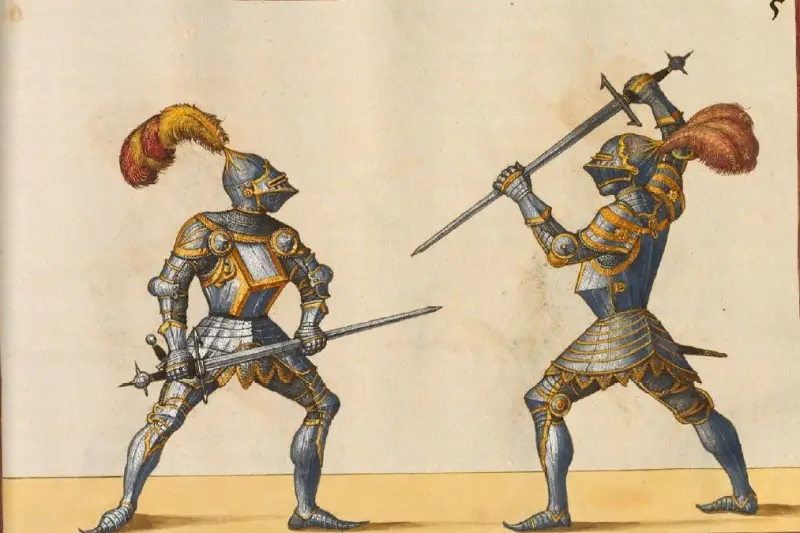
The most fierce was the last duel with the Burgundian squire Jean de Petois. Opponents fought with axes. Jacques de Lalen, like several times before, did not put any protection on his right leg. It was decided to fight with 63 blows [3].
Towards the end of the duel, the defending knight thrust the lower point of his ax into Pitua's face, wounding him. After that, they grabbed each other's shafts, and the challenger tried to punch the defender in the face three times. When all the blows had been struck, the fighters appeared before the judge, and de Lalen addressed Pitois with the following words:
To which Jean de Petois replied:
The completion of the padarma attracted a large number of spectators, both nobles and townspeople, who wanted to see the knight protector leave the lists for the last time. Jacques de Lalen performed his emprise in full accordance with the stated provisions, behaved nobly and chivalrously, and did not shy away from battle, which was recognized by the judges.
At the feast that followed, Jacques de Lalen presented the promised rewards to the most distinguished knights: Gerard de Roussillon (Gerard de Rochebaron) received a golden knight's axe, Jacques d'Avenchier received a golden sword as a reward, and Jean de Boniface received a golden spear.
The hero of the tournament, Jacques de Lalen, Duke of Burgundy Philip the Good, was not left without a gift and announced the decision to accept him into the ranks of the Order of the Golden Fleece, where Jacques’ uncle Simon de Lalen was already a member.
Использованная литература:
[1]. Golovachev I.V. History of the development of the knightly tournament. “World Science” No. 7 (40), 2020.
[2]. Maurice Keene. Chivalry. – M.: Scientific world, 2000.
[3]. Senichev V. E. The Last Knight Errant. – M.: Veche, 2023.
[4]. Huizinga Johan. Autumn of the Middle Ages / Comp., preface. and lane from the Netherlands D. V. Silvestrov; Commentary, indexes by D. E. Kharitonovich. – St. Petersburg: Ivan Limbach Publishing House, 2011.
[5]. Kurkin A. Burgundian wars in biographies. Olivier de La Marche. Warrior, politician and writer.
[6]. Zharkov S.V. Knights: the first complete encyclopedia. – M.: Eksmo; Yauza, 2016.
[7]. S. Matthew Galas. The Deeds of Jacques de Lalaing: Feats of Arms of a 15th Century Knight.
Information